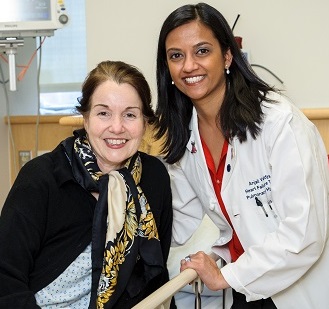 Saving a patient’s life can take days, weeks or even months. But, in the case of Kim Pimley, a patient with a rare, deadly heart disease, a combination of teamwork, solid clinical knowledge, and lifesaving technology administered over 24 hours made the difference between life and death.
Saving a patient’s life can take days, weeks or even months. But, in the case of Kim Pimley, a patient with a rare, deadly heart disease, a combination of teamwork, solid clinical knowledge, and lifesaving technology administered over 24 hours made the difference between life and death.
The clock starting ticking even before Pimley arrived Thursday afternoon last month on the cardiac care unit of the Hospital of the Unversity of Pennsylvania. That morning, interventional cardiologist Daniel Kolansky, MD, associate chief for Cardiovascular Clinical Affairs, had received the call for the transfer and spoken with Anjali Vaidya, MD, of Penn’s Heart Failure and Cardiac Transplant Program, about a patient he wanted to put on her service.
These types of patients often undergo a right heart catheterization to measure the heart’s pressures and flows and a coronary angiogram to make sure there’s no blockage cutting off the blood supply. But Vaidya knew in an instant that Pimley’s case was different. Noting her irregular heartbeats, the appearance of her echocardiogram and her rapidly deteriorating condition, Vaidya immediately spoke with Kolansky. “Forget the angiogram and let’s do a diagnostic heart biopsy…. It’s a top priority.”
Senior medical resident Tom Hanff, MD, alerted Pathology for a “stat interpretation” of the biopsy, but even before results came back, Vaidya knew this case was not typical. It was much worse: Vaidya suspected giant cell myocarditis.
Giant cell myocarditis is an inflammation of the heart that destroys its ability to beat normally. There is no known cause. Giant cell is so rare that, even today, it is not often considered in patients who present with new onset heart failure. In Penn's cardiovascular practice – which has seen thousands of patients with heart failure – “we not only know the exact number of cases of giant cell myocarditis we’ve treated over the years but can also recite the names of the patients,” she said.
While Pimley was still in the catheterization lab, Vaidya and Kolansky also decided to place an intra-aortic balloon pump, to help increase her blood flow. Based on the patient’s quickly worsening condition, Vaidya asked her to sign a consent for a heart transplant evaluation. Cardiac transplant coordinator Nicole Hornsby, CRNP, immediately put the wheels in motion for a possible transplant, which included ordering medical tests and blood work.
Vaidya alerted Pavan Alturi, MD, a Penn surgeon who performs heart transplants, to be prepared to put the patient on ECMO (extracorporeal membrane oxygenation) “at any moment.” The time came the following morning when Pimley showed no response to the balloon pump and medications and was suffering from an ongoing and progressive arrhythmia. She needed ECMO to stabilize her condition.
By mid-morning Friday, the diagnosis came back: giant cell myocarditis. By early that afternoon, transplant testing results came back and the entire cardiac team – including heart failure cardiologists, cardiac surgeons, nurse practitioners, social workers, the financial coordinator, and the remainder of the heart transplant team – came together and made a decision. Pimley was added to the heart transplant list, at the most urgent status.
Less than 24 hours had passed since she had arrived at HUP. That Sunday night, Gift of Life called with a possible heart and, by the following afternoon, it was beating in Pimley’s chest.
Read the upcoming issue of HUPdate this Friday, which will feature a deeper dive into this patient’s amazing story.